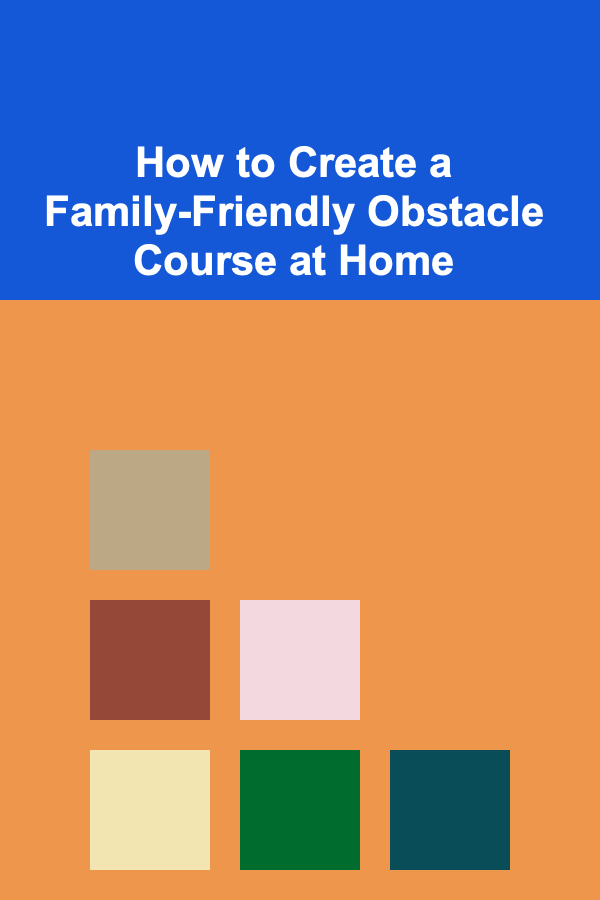
How to Create a Family-Friendly Obstacle Course at Home
ebook include PDF & Audio bundle (Micro Guide)
$12.99$5.99
Limited Time Offer! Order within the next:

Creating a family-friendly obstacle course at home is a fantastic way to engage in physical activity, encourage teamwork, and foster creativity. Whether you're looking to spend quality time with your loved ones or want to promote physical fitness, a home-based obstacle course provides endless possibilities for fun and exercise. What makes it even better is that you don't need expensive equipment or a huge space---just a little imagination and some household items can go a long way.
In this article, we'll guide you through how to design and create a family-friendly obstacle course in your home, the benefits of doing so, and tips for making the experience enjoyable for all ages. Whether you have toddlers, teenagers, or adults, there's something for everyone to enjoy. So let's dive into how you can create an exciting and safe obstacle course in the comfort of your own home!
Benefits of a Family-Friendly Obstacle Course
Before jumping into the logistics of how to build your obstacle course, let's take a moment to discuss the benefits it can offer for your family.
1. Promotes Physical Activity
In today's world, physical activity can sometimes take a back seat to screen time or sedentary hobbies. An obstacle course encourages movement, from crawling under tables to jumping over pillows. It's an excellent way to help family members stay active and fit without having to leave the house. It also provides an opportunity for parents and children to exercise together.
2. Enhances Creativity
A well-designed obstacle course requires imagination and problem-solving. As you set up the course, you'll likely need to think outside the box and find creative ways to use everyday household items. This creative process is not only fun, but it also helps develop critical thinking skills for both children and adults.
3. Improves Coordination and Balance
Completing an obstacle course requires a variety of physical skills such as balance, agility, and coordination. By practicing these skills in a fun and low-pressure environment, everyone can improve their physical abilities. Plus, it's a great way to help children develop better control over their bodies.
4. Builds Teamwork and Communication Skills
Obstacle courses are not just about physical strength---they also require communication and cooperation. Whether you're working together to navigate through the course or cheering each other on, the experience promotes positive social interactions, strengthens teamwork, and improves communication skills.
5. Encourages Bonding
One of the best things about building an obstacle course at home is that it provides an opportunity for family members to spend quality time together. It's a shared experience that brings everyone closer. You can work together to build the course, take turns going through it, and celebrate each other's successes. The bonds created through shared challenges can last a lifetime.
Steps to Creating Your Family-Friendly Obstacle Course
Creating an obstacle course at home may sound challenging, but it's easier than you might think. Here's a step-by-step guide to designing a fun and safe obstacle course for your family.
Step 1: Assess Your Space
The first step in designing an obstacle course is to assess the space where you'll be setting it up. Do you have a large living room, a spacious basement, or a backyard that's perfect for the course? Here are some things to consider:
- Indoors vs. Outdoors: If you have a spacious outdoor area, you might have more room to incorporate different types of obstacles, like running and climbing. On the other hand, indoor spaces might be better suited for smaller, low-impact challenges.
- Safety: Make sure the area is clear of any furniture, sharp objects, or anything that could be dangerous if someone trips or falls. Cushioning hard surfaces with pillows, mats, or blankets can help prevent injuries.
- Accessibility: Ensure that the course is accessible to everyone in your family. If you have young children, elderly relatives, or family members with mobility challenges, adjust the difficulty of obstacles to ensure everyone can participate safely.
Step 2: Decide on the Difficulty Level
Your obstacle course should be fun and challenging, but not so difficult that it becomes frustrating. Consider the ages and abilities of the participants in your family. You can create a course that ranges in difficulty by incorporating obstacles for different skill levels. Here are a few tips:
- For Young Children: Keep it simple with tasks like crawling under tables, hopping over small objects, or walking in a straight line to practice balance.
- For Teenagers and Adults: Increase the difficulty by adding challenges like jumping jacks, push-ups, or tasks that require strength and coordination, such as balancing on one foot or hopping over higher obstacles.
- Inclusive for All: Make sure there are elements that everyone can enjoy. For example, you can have some easy tasks for younger children and more complex ones for older family members, but everyone can participate in some way.
Step 3: Gather Your Materials
The beauty of a home obstacle course is that you don't need specialized equipment to get started. Look around your home for everyday items that can be repurposed as obstacles. Here's a list of common household items that can be used:
- Cushions and Pillows: Use cushions to create climbing challenges, jump pads, or obstacles to crawl over.
- Chairs and Tables: Create tunnels by draping a blanket over chairs or use tables for crawling under or jumping over.
- Rope or String: Use a rope tied between two objects to create a limbo or balance challenge. You can also use it to make hurdles that must be jumped over.
- Plastic Cups or Bottles: Stack plastic cups to create a course for balancing or to knock over.
- Tape or Chalk: Mark lines on the floor with tape or chalk to create paths or areas that must be crossed without stepping out of bounds.
- Towels, Blankets, or Rugs: Use towels or blankets to create a soft surface for crawling or rolling. You can also set up a "sliding" challenge by using towels on smooth floors.
Step 4: Plan the Obstacles
Now that you have your materials ready, it's time to start thinking about the obstacles. Here are a few ideas for obstacles that can be incorporated into your family-friendly course:
1. Crawl Under/Over Obstacles
Using tables, chairs, or blankets, create tunnels that family members must crawl under. You can also arrange cushions or pillows for participants to crawl over. Crawling builds core strength and coordination.
2. Balance Beam
Place a long, sturdy object like a piece of tape, a board, or even a towel on the floor to act as a balance beam. Participants will have to walk along it without falling off. This helps improve balance and concentration.
3. Jumping Over Objects
Set up low obstacles like pillows, soft toys, or hula hoops that family members must jump over. You can vary the height of the obstacles to make them more challenging for older participants.
4. Tightrope Walking
Use a rope or tape to create a "tightrope" that participants must walk across, requiring them to focus on balance. To make it easier, place the rope on the floor rather than hanging it.
5. Crawling Under or Through Hula Hoops
Hula hoops can be hung or placed flat on the floor for participants to crawl under or jump through. You can also stack them to create a tunnel or use them for a target challenge.
6. Push-Ups or Squats
To add strength-building elements, incorporate push-ups, squats, or jumping jacks into the course. For example, after crawling through one obstacle, participants might need to complete a set number of push-ups before moving on to the next challenge.
7. Ladder or Obstacle Weaving
If you have a small ladder or a set of cones, set them up in a zigzag pattern. Participants will need to weave in and out of the obstacles to complete the challenge. This helps improve agility and coordination.
8. Throwing Objects into Baskets
Set up baskets or containers and challenge participants to throw small objects, such as bean bags or socks, into them. This adds an element of hand-eye coordination.
Step 5: Test and Adjust the Course
Once your obstacle course is set up, it's time to test it out. Go through the course yourself, and ask family members to give it a try. This is a great time to adjust the difficulty of certain obstacles to make sure they're challenging but not overwhelming. You can also make sure the obstacles are safe and that everyone can complete them without any issues.
Step 6: Create a Game or Challenge Format
To make the obstacle course even more engaging, turn it into a game. Here are a few ways you can make the experience competitive or goal-oriented:
- Time Trials: Have each family member go through the course one at a time and time them to see who completes it the fastest.
- Relay Race: Pair up with another family member and complete the course together, taking turns. This encourages teamwork and adds a competitive aspect.
- Point System: Assign points for each obstacle completed, and add up the total points at the end. Whoever accumulates the most points wins a prize or earns bragging rights!
Final Tips for a Successful Family Obstacle Course
- Adapt for Age and Ability: Adjust the course based on the ages and abilities of your family members. Make sure everyone can participate, from toddlers to grandparents.
- Safety First: Ensure that obstacles are safe, and soft surfaces like cushions or rugs are used for any risky activities. Supervise younger children during the course.
- Have Fun!: The goal is to have fun and create lasting memories. Don't stress about making the course perfect---embrace creativity, laughter, and moments of joy as a family.
Conclusion
Creating a family-friendly obstacle course at home is a rewarding way to encourage physical activity, improve coordination, and foster communication between family members. Whether you have a small apartment or a spacious backyard, there are endless ways to design a course that will bring fun and fitness to your family's routine. So gather some household items, get creative, and enjoy the challenge of building an obstacle course that will keep everyone entertained and moving!

How to Avoid Common Investment Mistakes
Read More
How to Clean Windows Without Leaving Streaks
Read More
How to Create a Stunning Gallery Wall on a Budget
Read More
How to Handle Moving Difficult Items Like Pianos or Artwork
Read More
How to Make a Family Vision Board for Goals and Dreams
Read More
How to Use Digital Tools for Home Maintenance Management
Read MoreOther Products

How to Avoid Common Investment Mistakes
Read More
How to Clean Windows Without Leaving Streaks
Read More
How to Create a Stunning Gallery Wall on a Budget
Read More
How to Handle Moving Difficult Items Like Pianos or Artwork
Read More
How to Make a Family Vision Board for Goals and Dreams
Read More